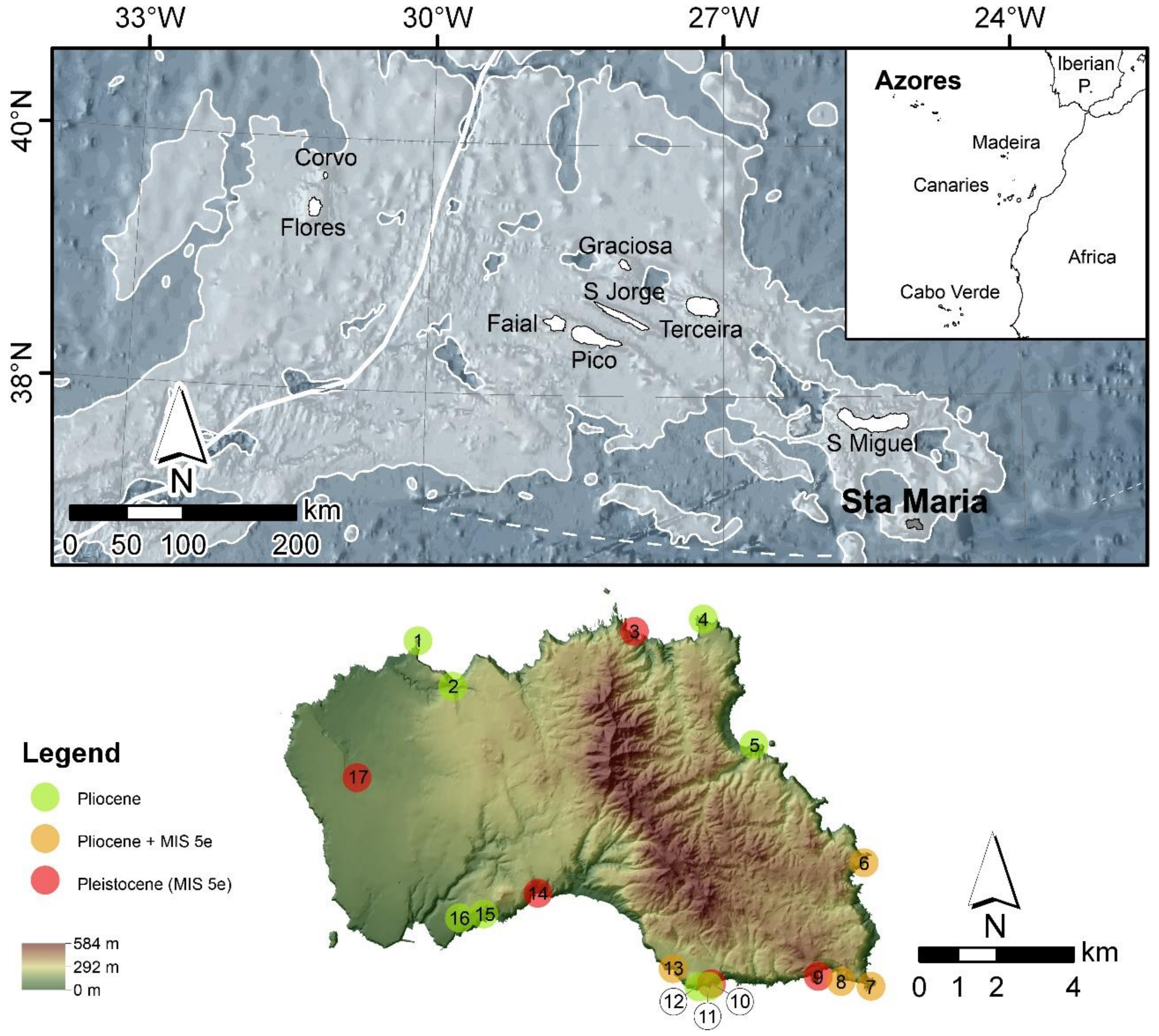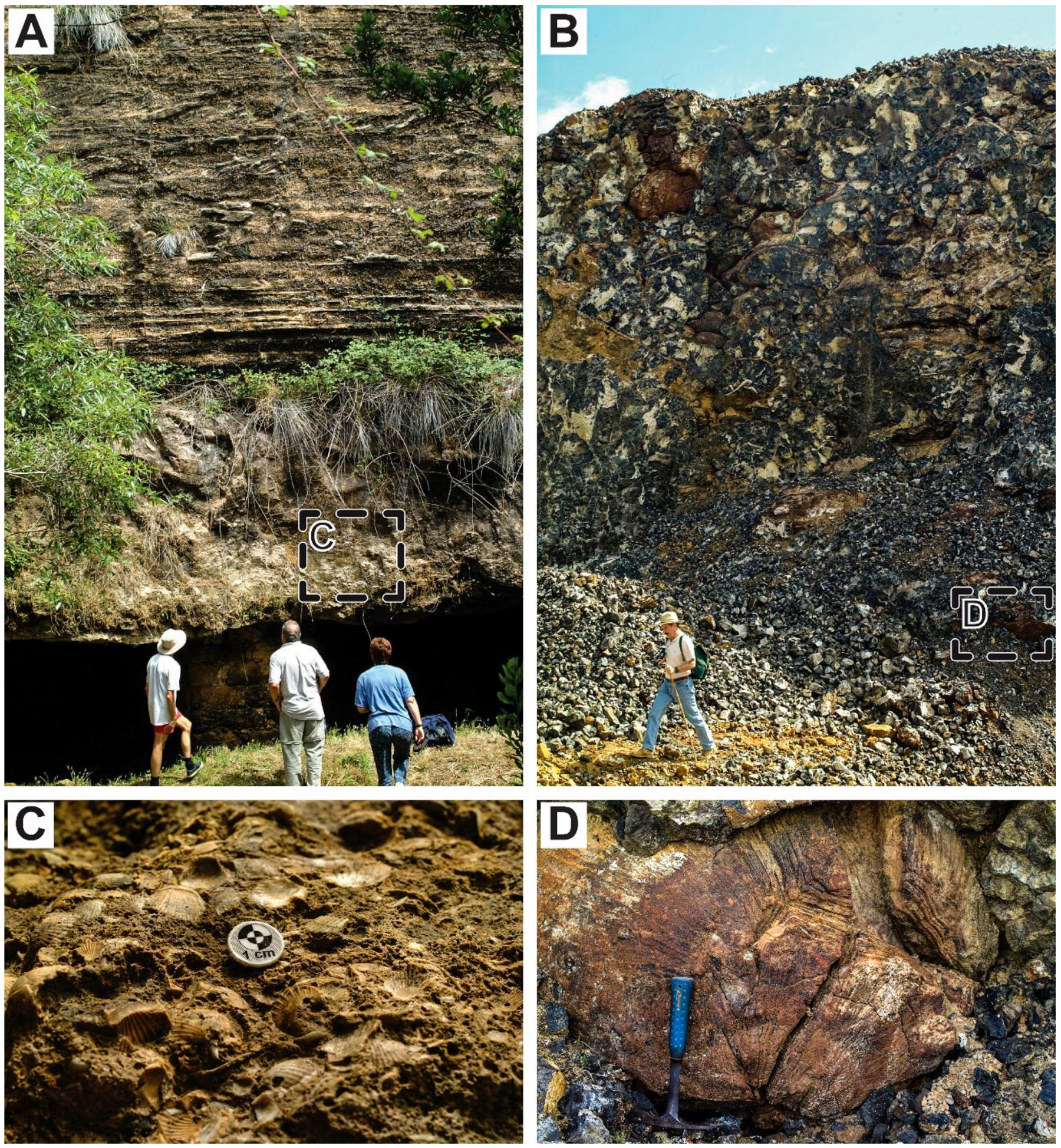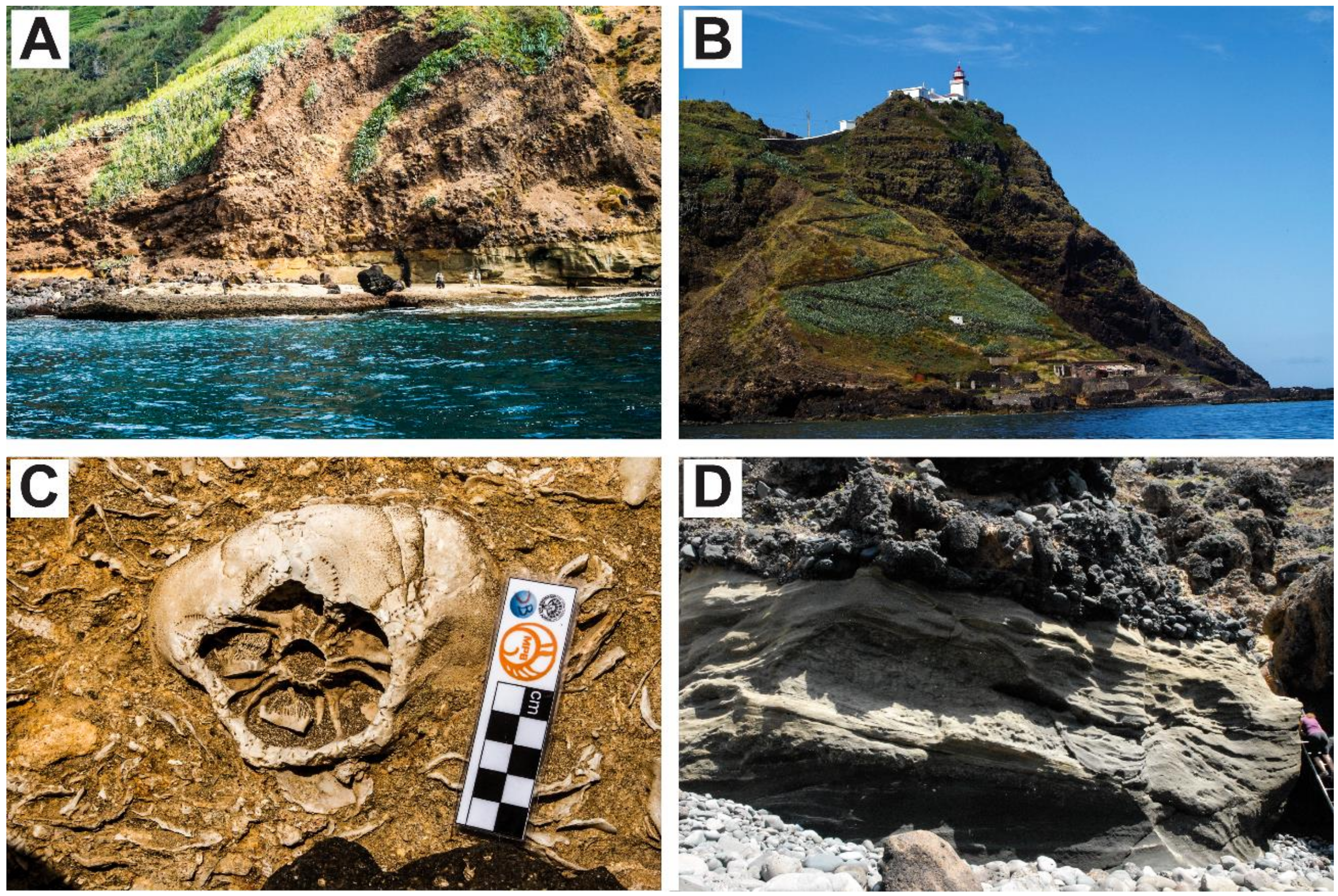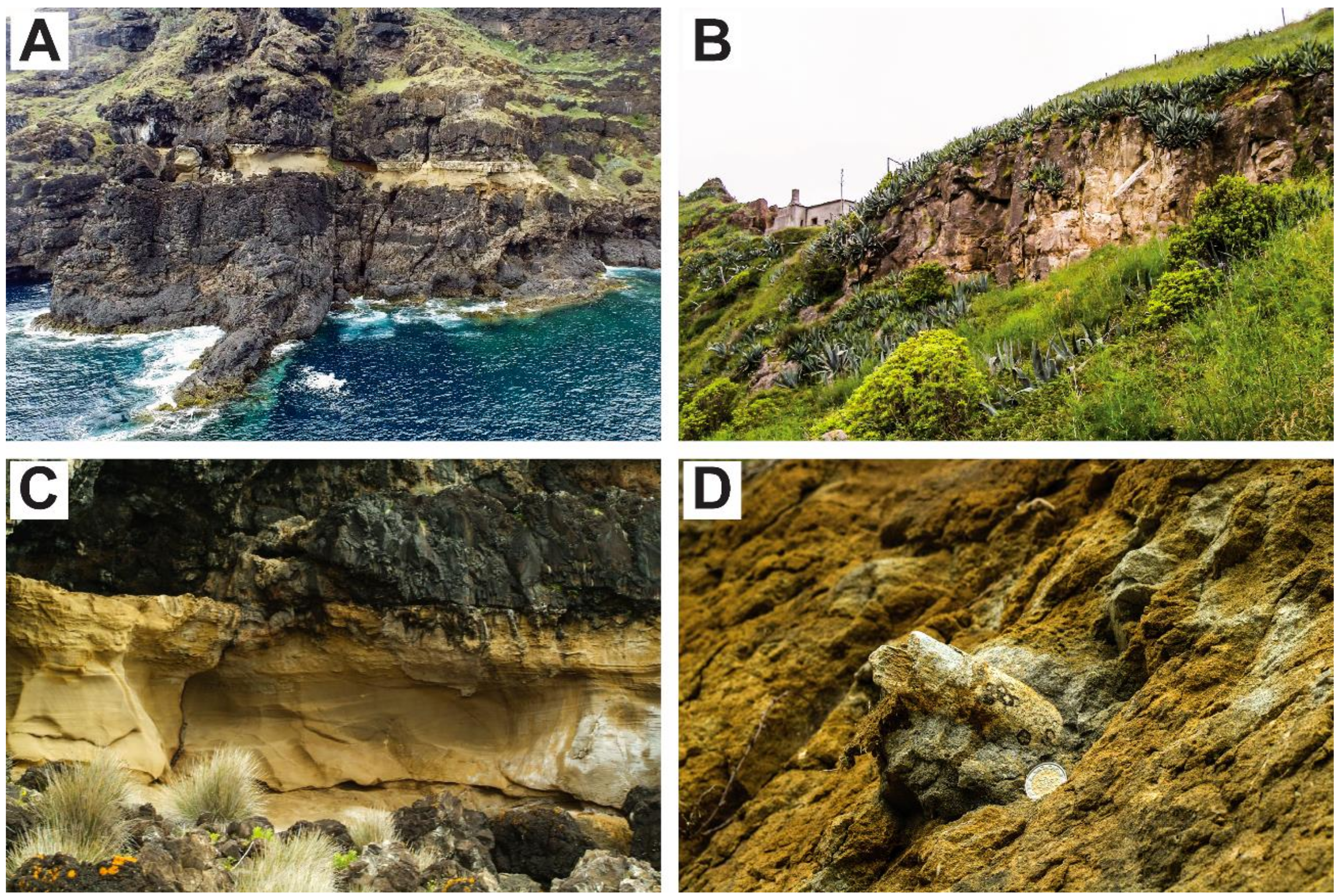Comparing Methods of Evaluation of Geosites: The Fossiliferous Outcrops of Santa Maria Island (Azores, NE Atlantic) as a Case Study for Sustainable Island Tourism
Abstract
:1. Introduction
2. The Azores Archipelago: Geographic and Geotectonic Setting
2.1. Santa Maria Island: Geological and Palaeontological Studies
2.2. Geoheritage Studies in Santa Maria Island
3. Materials and Methods
4. Results
5. Discussion
5.1. Scientific Value
5.2. Educational and Touristic Potential Uses
5.3. Degradation Risk
5.4. Conservation and Management of Palaeontological Geosites
6. Conclusions
Supplementary Materials
Author Contributions
Funding
Acknowledgments
Conflicts of Interest
References
- Gray, M. Geodiversity: Valuing and Conserving Abiotic Nature; John Wiley & Sons: Blackwell, UK, 2013; pp. 1–512. ISBN 978-0-470-74215-0. [Google Scholar]
- Brilha, J. Inventory and quantitative assessment of geosites and geodiversity sites: A review. Geoheritage 2016, 8, 119–134. [Google Scholar] [CrossRef] [Green Version]
- Bruno, D.E.; Crowley, B.E.; Gutak, J.M.; Moroni, A.; Nazarenko, O.V.; Oheim, K.; Ruban, D.A.; Tiess, G.; Zorina, S.O. Paleogeography as geological heritage: Developing geosite classification. Earth-Sci. Rev. 2014, 138, 300–312. [Google Scholar] [CrossRef]
- Reynard, E.; Fontana, G.; Kozlik, L.; Scapozza, C. A method for assessing the scientific and additional values of geomorphosites. Geogr. Helv. 2007, 62, 148–158. [Google Scholar] [CrossRef]
- Henriques, M.H.; Pena dos Reis, R.; Brilha, J.; Mota, T. Geoconservation as an emerging geoscience. Geoheritage 2011, 3, 117–128. [Google Scholar] [CrossRef] [Green Version]
- Sharples, C. Concepts and Principles of Geoconservation; Tasmanian Parks & Wildlife Service: Hobart, Australia, 2002; pp. 1–179. [Google Scholar]
- Prosser, C.D. Our rich and varied geoconservation portfolio: The foundation for the future. Proc. Geol. Assoc. 2013, 124, 568–580. [Google Scholar] [CrossRef]
- Prosser, C.D.; Brown, E.J.; Jonathan, G.L.; Bridgland, D.R. Geoconservation for science and society—An agenda for the future. Proc. Geol. Assoc. 2013, 124, 561–567. [Google Scholar] [CrossRef]
- Dowling, R.K. Global geotourism—An emerging form of sustainable tourism. Czech J. Tour. 2013, 2, 59–79. [Google Scholar] [CrossRef]
- Bruschi, V.M.; Cendrero, A. Geosite evaluation: Can we measure intangible values? Il Quaternario 2005, 18, 293–306. [Google Scholar]
- Serrano, E.; González-Trueba, J.J. Assessment of geomorphosites in natural protected areas: The Picos de Europa National Park (Spain). Géomorphol. Relief Process. Environ. 2005, 3, 197–208. [Google Scholar] [CrossRef]
- Coratza, P.; Bruschi, V.; Piacentini, D.; Saliba, D.; Soldati, M. Recognition and assessment of Geomorphosites in Malta at the Il-Majjistral Natural and History Park. Geoheritage 2011, 3, 175–185. [Google Scholar] [CrossRef] [Green Version]
- Pereira, D.I.; Pereira, P.; Brilha, J.; Cunha, P.P. The Iberian Massif Landscape and Fluvial Network in Portugal: A geoheritage inventory based on the scientific value. Proc. Geol. Assoc. 2015, 126, 252–265. [Google Scholar] [CrossRef]
- Reynard, E.; Perret, A.; Bussard, J.; Grangier, L.; Martin, S. Integrated Approach for the Inventory and Management of Geomorphological Heritage at the Regional Scale. Geoheritage 2016, 8, 43–60. [Google Scholar] [CrossRef]
- Cappadonia, C.; Coratza, P.; Agnesi, V.; Soldati, M. Malta and Sicily Joined by Geoheritage Enhancement and Geotourism within the Framework of Land Management and development. Geosciences 2018, 8, 253. [Google Scholar] [CrossRef]
- Dowling, R.K.; Newsone, D. (Eds.) Geotourism; Elsevier: London, UK, 2005; pp. 1–352. ISBN 978-0-7506. [Google Scholar]
- Kubalíková, L.; Kirchner, K. Geosite and geomorphosite assessment as a tool for geoconservation and geotourism purposes: A case study from Vizovická vrchovina Highland (Eastern part of the Czech Republic). Geoheritage 2016, 8, 5–14. [Google Scholar] [CrossRef]
- Hose, T.A. European Geotourism—Geological Interpretation and Geoconservation Promotion for Tourists. In Geological Heritage: Its Conservation and Management; Barretino, D., Wimbledon, W.A.P., Gallego, E., Eds.; Sociedad Geológica de España/Instituto Tecnológico GeoMinero de España/ProGEO: Madrid, Spain, 2000; pp. 127–146. ISBN 84-7840-417-1. [Google Scholar]
- Ávila, S.P.; Cachão, M.; Ramalho, R.S.; Botelho, A.Z.; Madeira, P.; Rebelo, A.C.; Cordeiro, R.; Melo, C.; Hipólito, A.; Ventura, M.A.; et al. The palaeontological heritage of Santa Maria Island (Azores: NE Atlantic): A re-evaluation of geosites in GeoPark Azores and their use in geotourism. Geoheritage 2016, 8, 155–171. [Google Scholar] [CrossRef]
- Laughton, A.S.; Whitmarsh, R.B. The Azores-Gibraltar plate boundary. In Geodynamics of Iceland and the North Atlantic Area; Kristjansson, L., Ed.; Riedel: Kufstein, Austria, 1974; pp. 63–81. [Google Scholar]
- Searle, R. Tectonic pattern of the Azores spreading centre and triple junction. Earth Planet. Sci. Lett. 1980, 51, 415–434. [Google Scholar] [CrossRef]
- Needham, H.D.; Francheteau, J. Some characteristics of the rift valley in the Atlantic Ocean near 36°48’ north. Earth Planet. Sci. Lett. 1974, 22, 29–43. [Google Scholar] [CrossRef]
- Ramalho, R.S.; Helffrich, G.; Madeira, J.; Cosca, M.; Thomas, C.; Quartau, R.; Hipólito, A.; Rovere, A.; Hearty, P.J.; Ávila, S.P. Emergence and evolution of Santa Maria Island (Azores)—The conundrum of uplifted islands revisited. Geol. Soc. Am. Bull. 2017, 129, 372–390. [Google Scholar] [CrossRef]
- Estevens, M.; Ávila, S.P. Fossil whales from the Azores. Açoreana 2007, Supl. 5, 140–161. [Google Scholar]
- Ávila, S.P.; Cordeiro, R.; Rodrigues, A.R.; Rebelo, A.C.; Melo, C.S.; Madeira, P.; Pyenson, N.D. Fossil Mysticeti from the Pleistocene of Santa Maria Island, Azores (Northeast Atlantic Ocean), and the prevalence of fossil cetaceans on oceanic islands. Palaeontol. Electron. 2015, 18, 1–12. [Google Scholar] [CrossRef]
- Ávila, S.P.; Ramalho, R.; Vullo, R. Systematics, palaeoecology and palaeobiogeography of the Neogene fossil sharks from the Azores (Northeast Atlantic). Annales de Paléontologie 2012, 98, 167–189. [Google Scholar] [CrossRef]
- Uchman, A.; Torres, P.; Johnson, M.E.; Berning, B.; Ramalho, R.S.; Rebelo, A.C.; Melo, C.S.; Baptista, L.; Madeira, P.; Cordeiro, R.; et al. Feeding traces of recente ray fish and occurrences of the trace fossil Piscichnus waitemata from the Pliocene of Santa Maria Island, Azores (Northeast Atlantic). Palaios 2018, 33, 361–375. [Google Scholar] [CrossRef]
- Madeira, P.; Kroh, A.; Cordeiro, R.; Meireles, R.; Ávila, S.P. The fossil echinoids of Santa Maria Island, Azores (Northern Atlantic Ocean). Acta Geol. Pol. 2011, 61, 243–264. [Google Scholar]
- Winkelmann, K.; Buckeridge, J.S.; Costa, A.C.; Dionísio, M.A.M.; Medeiros, A.; Cachão, M.; Ávila, S.P. Zullobalanus santamariaensis sp. nov. a new late Miocene barnacle species of the family Archeobalanidae (Cirripedia: Thoracica), from the Azores. Zootaxa 2010, 2680, 33–44. [Google Scholar]
- Uchman, A.; Quintino, V.; Rodrigues, A.M.; Johnson, M.E.; Melo, C.; Cordeiro, R.; Ramalho, R.S.; Ávila, S.P. The trace fossil Diopatrichnus santamariaensis nov. isp.—A shell armoured tube from Pliocene sediments of Santa Maria Island, Azores (NE Atlantic Ocean). Geobios 2017, 50, 459–469. [Google Scholar] [CrossRef]
- Uchman, A.; Johnson, M.E.; Rebelo, A.C.; Melo, C.; Cordeiro, R.; Ramalho, R.S.; Ávila, S.P. Vertically-oriented trace fossil Macaronichnus segregatis from Neogene of Santa Maria Island (Azores; NE Atlantic) records vertical fluctuations of the coastal groundwater mixing zone on a small oceanic island. Geobios 2016, 49, 229–241. [Google Scholar] [CrossRef]
- Ávila, S.P.; Ramalho, R.S.; Habermann, J.M.; Quartau, R.; Kroh, A.; Berning, B.; Johnson, M.E.; Kirby, M.X.; Zanon, V.; Titschack, J.; et al. Palaeoecology, taphonomy, and preservation of a lower Pliocene shell bed (coquina) from a volcanic oceanic island (Santa Maria Island, Azores). Palaeogeogr. Palaeoclimatol. Palaeoecol. 2015, 430, 57–73. [Google Scholar] [CrossRef] [Green Version]
- Ávila, S.P.; Melo, C.; Berning, B.; Cordeiro, R.; Landau, B.; Da Silva, C.M. Persististrombus coronatus (Mollusca: Strombidae) in the early Pliocene of Santa Maria Island (Azores: NE Atlantic): Palaeoecology, palaeoclimatology and palaeobiogeographic implications on the NE Atlantic Molluscan Biogeographical Provinces. Palaeogeogr. Palaeoclimatol. Palaeoecol. 2016, 441, 912–923. [Google Scholar] [CrossRef]
- Janssen, A.W.; Kroh, A.; Ávila, S.P. Early Pliocene heteropods and pteropods (Mollusca, Gastropoda) from Santa Maria (Azores, Portugal): Systematics and biostratigraphic implications. Acta Geol. Pol. 2008, 58, 355–369. [Google Scholar]
- Kroh, A.; Bitner, M.A.; Ávila, S.P. Novocrania turbinata (Brachiopoda) from the Early Pliocene of the Azores (Portugal). Acta Geol. Pol. 2008, 58, 473–478. [Google Scholar]
- Meireles, R.P.; Faranda, C.; Gliozzi, E.; Pimentel, A.; Zanon, V.; Ávila, S.P. Late Miocene marine ostracods from Santa Maria Island, Azores (NE Atlantic): Systematics, palaeoecology and palaeobiogeography. Révue de Micropaléontologie 2012, 55, 133–148. [Google Scholar] [CrossRef]
- Rebelo, A.C.; Rasser, M.W.; Riosmena-Rodríguez, R.; Neto, A.I.; Ávila, S.P. Rhodolith forming coralline algae in the Upper Miocene of Santa Maria Island (Azores, NE Atlantic): A critical evaluation. Phytotaxa 2014, 190, 370–382. [Google Scholar] [CrossRef]
- Rebelo, A.C.; Meireles, R.P.; Barbin, V.; Neto, A.I.; Melo, C.; Ávila, S.P. Diagenetic history of lower Pliocene rhodoliths of the Azores archipelago (NE Atlantic): Application of cathodoluminescence techniques. Micron 2016, 80, 112–121. [Google Scholar] [CrossRef] [PubMed]
- Rebelo, A.C.; Rasser, M.W.; Kroh, A.; Johnson, M.E.; Ramalho, R.S.; Melo, C.; Uchman, A.; Berning, B.; Silva, L.; Zanon, V.; et al. Rocking around a volcanic island shelf: Pliocene rhodolith beds from Malbusca, Santa Maria Island (Azores, NE Atlantic). Facies 2016, 62, 1–31. [Google Scholar] [CrossRef]
- Ávila, S.P.; Ramalho, R.; Habermann, J.; Titschack, J. The marine fossil record at Santa Maria Island (Azores). In Volcanoes of the Azores. Revealing the Geological Secrets of the Central Northern Atlantic Islands. Active Volcanoes of the World; Kueppers, U., Beier, C., Eds.; Springer: Berlin, Germany, 2018; pp. 155–196. [Google Scholar]
- Lima, E. Património Geológico dos Açores: Valorização de Locais com Interesse Geológico das Áreas Ambientais, Contributo Para o Ordenamento do Território. Master’s Thesis, Universidade dos Açores, Ponta Delgada, Portugal, 2007. (In Portuguese). [Google Scholar]
- Nunes, J.C.; Lima, E.A.; Ponte, D.; Costa, M.P.; Castro, R. Azores Geopark Application; Azores Geopark: Horta, Portugal, 2011; pp. 1–50. Available online: http://www.azoresgeopark.com/media/docs/candidatura_ga/Application.pdf (accessed on 15 May 2018).
- Lima, E.A.; Nunes, J.C.; Costa, M.P.; Machado, M. Basis for the geological heritage management in the Azores Archipelago (Portugal). J. Integr. Coast. Zone Manag. 2014, 14, 301–319. [Google Scholar] [CrossRef]
- Lima, E.A.; Nunes, J.C.; Medeiros, S. Divulgação do património geológico da ilha de Santa Maria. Relatórios e Comunicações do Departamento de Biologia 2009, 36, 19–27. (In Portuguese) [Google Scholar]
- Nunes, J.C.; Lima, E.A.; Medeiros, S. Carta de Geossítios da ilha de Santa Maria (Açores). Escala 1:50,000; Departamento de Geociências, Universidade dos Açores: Ponta Delgada, Portugal, 2008. (In Portuguese) [Google Scholar]
- Brilha, J.B. Património Geológico e Geoconservação: A Conservação da Natureza na sua Vertente Geológica; Palimage Editores: Viseu, Portugal, 2005; pp. 1–190, (In Portuguese). ISBN 972-8575-90-4. [Google Scholar]
- Bruschi, V.M.; Cendrero, A.; Albertos, J.A.C. A statistical approach to the validation and optimization of geoheritage assessment procedures. Geoheritage 2011, 3, 131–149. [Google Scholar] [CrossRef]
- Fassoulas, C.; Mouriki, D.; Dimitriou-Nikolakis, P.; Iliopoulos, G. Quantitative assessment of geotopes as an effective tool for geoheritage management. Geoheritage 2012, 4, 177–193. [Google Scholar] [CrossRef]
- Meireles, R.P.; Quartau, R.; Ramalho, R.S.; Rebelo, A.C.; Madeira, J.; Zanon, V.; Ávila, S.P. Depositional processes on oceanic island shelves—Evidence from storm-generated Neogene deposits from the mid-North Atlantic. Sedimentology 2013, 60, 1769–1785. [Google Scholar] [CrossRef]
- Sibrant, A.L.R.; Hildenbrand, A.; Marques, F.O.; Costa, A.C.G. Volcano-tectonic evolution of the Santa Maria Island (Azores): Implications for paleostress evolution at the western Eurasia-Nubia plate boundary. J. Volcanol. Geotherm. Res. 2015, 291, 49–62. [Google Scholar] [CrossRef]
- Ávila, S.P.; Rebelo, A.C.; Medeiros, A.; Melo, C.S.; Gomes, C.; Bagaço, L.; Madeira, P.; Borges, P.A.; Monteiro, P.; Cordeiro, R.; et al. Os fósseis de Santa Maria (Açores): A jazida da Prainha; OVGA—Observatório Vulcanológico e Geotérmico dos Açores: Lagoa, Portugal, 2010. (In Portuguese) [Google Scholar]
- Ávila, S.P.; Amen, R.; Azevedo, J.M.N.; Cachão, M.; García-Talavera, F. Checklist of the Pleistocene marine molluscs of Prainha and Lagoinhas (Santa Maria Island, Azores). Açoreana 2002, 9, 343–370. [Google Scholar]
- Ávila, S.P.; Madeira, P.; García-Talavera, F.; Da Silva, C.M.; Cachão, M.; Martins, A.M.F. Luria lurida (Mollusca: Gastropoda), a new record for the Pleistocene of Santa Maria (Azores, Portugal). Arquipélago 2007, 24, 53–56. [Google Scholar]
- Ávila, S.P.; Madeira, P.; Da Silva, C.M.; Cachão, M.; Landau, B.; Quartau, R.; Martins, A.M.F. Local disappearance of bivalves in the Azores during the last glaciation. J. Quat. Sci. 2008, 23, 777–785. [Google Scholar] [CrossRef]
- Ávila, S.P.; Madeira, P.; Mendes, N.; Rebelo, A.C.; Medeiros, A.; Gomes, C.; García-Talavera, F.; Da Silva, C.M.; Cachão, M.; Hillaire-Marcel, C.; et al. Mass extinctions in the Azores during the last glaciation: Fact or myth? J. Biogeogr. 2008, 35, 1123–1129. [Google Scholar] [CrossRef]
- Ávila, S.P.; Madeira, P.; Zazo, C.; Kroh, A.; Kirby, M.; da Silva, C.M.; Cachão, M.; Martins, A.M.F. Palaeoecology of the Pleistocene (MIS 5.5) outcrops of Santa Maria Island (Azores) in a complex oceanic tectonic setting. Palaeogeogr. Palaeoclimatol. Palaeoecol. 2009, 274, 18–31. [Google Scholar] [CrossRef]
- Ávila, S.P.; da Silva, C.M.; Schiebel, R.; Cecca, F.; Backeljau, T.; Martins, A.M.F. How did they get here? Palaeobiogeography of the Pleistocene marine molluscs of the Azores. Bull. Geol. Soc. Fr. 2009, 180, 201–213. [Google Scholar] [CrossRef]
- Ávila, S.P.; Melo, C.; Silva, L.; Ramalho, R.; Quartau, R.; Hipólito, A.; Cordeiro, R.; Rebelo, A.C.; Madeira, P.; Rovere, A.; et al. A review of the MIS 5e highstand deposits from Santa Maria Island (Azores, NE Atlantic): Palaeobiodiversity, palaeoecology and palaeobiogeography. Quat. Sci. Rev. 2015, 114, 126–148. [Google Scholar] [CrossRef]
- Cachão, M.; Madeira, J.; Marques Da Silva, C.; Azevedo, J.M.N.; Cruz, A.P.; Garcia, C.; Sousa, F.; Melo, J.; Aguiar, M.; Silva, P.; et al. Pedreira do Campo (Santa Maria, Açores): Monumento natural. Ciências da Terra (UNL) 2003, V, 120–123. (In Portuguese) [Google Scholar]
- Fuertes-Gutiérrez, I.; García-Ortiz, E.; Fernández-Martínez, E. Anthropic threats to geological heritage: Characterization and management: A case study in the dinosaur tracksites of La Rioja (Spain). Geoheritage 2016, 8, 135–153. [Google Scholar] [CrossRef]
- Dudley, N. Guidelines for Applying Protected Area Management Categories; IUCN: Gland, Switzerland, 2008; p. 86. ISBN 978-2-8317-1086-0. [Google Scholar]
- Pralong, J.P. A method for assessing the tourist potential and use of geomorphological sites. Géomorphol. Relief Process. Environ. 2005, 3, 189–196. [Google Scholar] [CrossRef]
- Clifton, D.; Amran, A. The stakeholder approach: A sustainability perspective. J. Bus. Ethics 2011, 98, 121–136. [Google Scholar] [CrossRef]
- Fraga, V. Azores tourism: A development and marketing strategy. Worldw. Hosp. Tour. Themes 2016, 8, 705–710. [Google Scholar] [CrossRef]
- Valls, J.-P.; Porta, F. Sustainable tourism and economy; Territory and heritage. Tour. Rev. 1997, 52, 3–10. [Google Scholar] [CrossRef]
- Dávid, L. Tourism ecology: Towards the responsible, sustainable tourism future. Worldw. Hosp. Tour. Themes 2011, 3, 210–216. [Google Scholar] [CrossRef]





| Fossiliferous Outcrops | Total/Value/Potential Use | ||||
|---|---|---|---|---|---|
| Q [19] | Scientific Value | Potential Educational Use | Potential Touristic Use | Degradation Risk | |
| Ponta do Castelo | 1 | 1 | 6 | 7 | 6 |
| Prainha | 2 | 4 | 1 | 1 | 1 |
| Malbusca | 3 | 3 | 12 | 12 | 7 |
| Pedra-que-Pica | 4 | 2 | 5 | 5 | 6 |
| Figueiral | 5 | 10 | 4 | 3 | 4 |
| Pedreira do Campo | 6 | 9 | 2 | 1 | 3 |
| Lagoinhas | 7 | 8 | 5 | 7 | 6 |
| Cré | 8 | 9 | 3 | 4 | 6 |
| Airport Area | 9 | 6 | 7 | 6 | 2 |
| Ponta do Cedro | 10 | 8 | 10 | 9 | 7 |
| Ichnofossils’ cave | 11 | 5 | 8 | 9 | 6 |
| Ponta do Norte | 12 | 11 | 9 | 8 | 5 |
| Ponta da Baía de Nª Senhora | 13 | 12 | 14 | 12 | 7 |
| Vinha Velha | 13 | 7 | 11 | 11 | 7 |
| Ponta dos Frades | 14 | 11 | 13 | 10 | 7 |
| Ponta Negra | 15 | 11 | 11 | 2 | 6 |
| Pedrinha da Cré | 16 | 12 | 14 | 12 | 7 |
© 2018 by the authors. Licensee MDPI, Basel, Switzerland. This article is an open access article distributed under the terms and conditions of the Creative Commons Attribution (CC BY) license (http://creativecommons.org/licenses/by/4.0/).
Share and Cite
Raposo, V.B.; Melo, C.S.; Silva, L.; Ventura, A.; Câmara, R.; Pombo, J.; Johnson, M.E.; Ávila, S.P. Comparing Methods of Evaluation of Geosites: The Fossiliferous Outcrops of Santa Maria Island (Azores, NE Atlantic) as a Case Study for Sustainable Island Tourism. Sustainability 2018, 10, 3596. https://doi.org/10.3390/su10103596
Raposo VB, Melo CS, Silva L, Ventura A, Câmara R, Pombo J, Johnson ME, Ávila SP. Comparing Methods of Evaluation of Geosites: The Fossiliferous Outcrops of Santa Maria Island (Azores, NE Atlantic) as a Case Study for Sustainable Island Tourism. Sustainability. 2018; 10(10):3596. https://doi.org/10.3390/su10103596
Chicago/Turabian StyleRaposo, Vera B., Carlos S. Melo, Luís Silva, Anunciação Ventura, Rita Câmara, Joana Pombo, Markes E. Johnson, and Sérgio P. Ávila. 2018. "Comparing Methods of Evaluation of Geosites: The Fossiliferous Outcrops of Santa Maria Island (Azores, NE Atlantic) as a Case Study for Sustainable Island Tourism" Sustainability 10, no. 10: 3596. https://doi.org/10.3390/su10103596
APA StyleRaposo, V. B., Melo, C. S., Silva, L., Ventura, A., Câmara, R., Pombo, J., Johnson, M. E., & Ávila, S. P. (2018). Comparing Methods of Evaluation of Geosites: The Fossiliferous Outcrops of Santa Maria Island (Azores, NE Atlantic) as a Case Study for Sustainable Island Tourism. Sustainability, 10(10), 3596. https://doi.org/10.3390/su10103596








